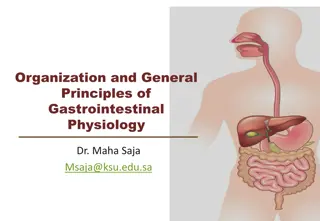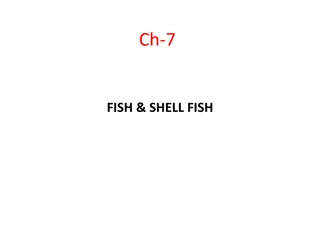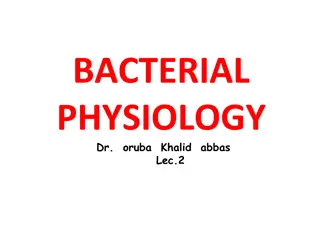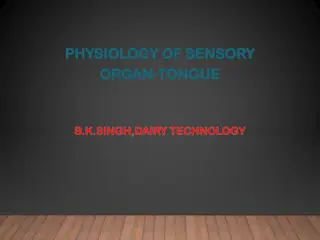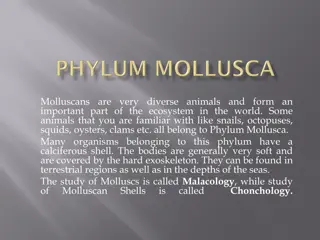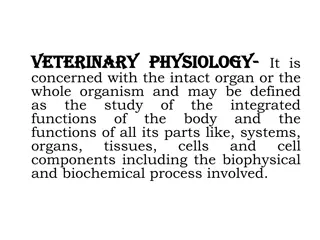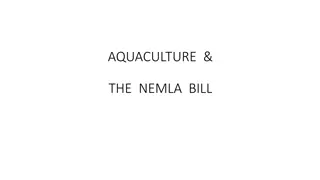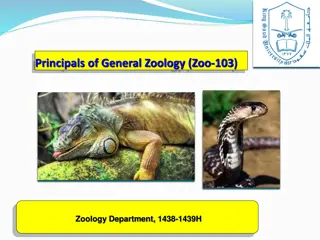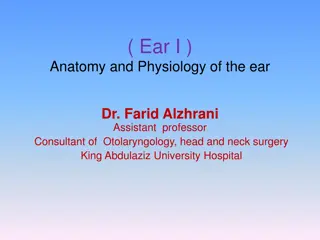Overview of Molluscs Physiology and Characteristics
Explore the fascinating world of molluscs through this detailed content featuring images and descriptions of various molluscan classes like Aplacophora, Polyplacophora (Chitons), and Monoplacophora. Discover key characteristics, unique traits, and structures of these diverse marine organisms. Learn about the shell-less Aplacophora, rock-clinging Polyplacophora, and rare Monoplacophora, each with distinct adaptations for survival in their habitats.
Download Presentation

Please find below an Image/Link to download the presentation.
The content on the website is provided AS IS for your information and personal use only. It may not be sold, licensed, or shared on other websites without obtaining consent from the author. Download presentation by click this link. If you encounter any issues during the download, it is possible that the publisher has removed the file from their server.
E N D
Presentation Transcript
Physiology of Molluscs By: Lila Boudrie
Unknown Organism Nicholas E. Curtis and Ray Martinez http://www.dreamviews.com/science-mathematics/151051-only- animal-able-do-photosynthesis-beautiful-sea-slug-eastern-emerald- elysia.html
Key Characteristics Has a head and a foot Lead us to the phylum Mollusca Class Gastropoda
Aplacophora https://commons.wikimedia.org/wiki/File: Epimenia_australis.jpg
Aplacophora Shell less, worm like animal Mantle is covered in protective spicules Similar body plan to chitons Well developed cerebral ganglion Lateral nerve cord No eye spots or specialized sensory organs
Aplacophora Radula Little/if any at all of a foot structure present Simple digestive system Odontophore (muscle support)
Polyplacophora https://www.flickr.com/photos/mattknoth/432805335
Polyplacophora (Chitons) Cling to rocks in the surf Do this by using their powerful foot Mantle (sturdy shell) Gills are on either side of the animal in a groove between the mantle and foot Radula Used to break down food
Polyplacophora Cont Subradular organ Chemical sensing organ tells the chiton there is food near by Longitudinal muscle Allows them to roll up if ever separated from a rock or the ocean floor Light sensing organs Called Aesthetes located on dorsal shell plates that detect water movement Eyes Located on the inside or outside of the aesthetes Able to detect light or shadows
Monoplacophora https://commons.wikimedia.org/wiki/File:Pilina_unguis.jpg
https://commons.wikimedia.org/wiki/File:Monoplacophora.svg Revised 11/29/17
Monoplacophora Posterior gonad Single symmetrical shell Mantle cavity separates the edge of the foot and the mantle Contains the mouth and gills
Gastropoda (snails & slugs) http://www.dreamviews.com/science-mathematics/151051-only-animal-able-do-photosynthesis-beautiful-sea-slug-eastern- emerald-elysia.html
Gastropoda 3 main groups Prosobranchia, opisthobranchia, pulmonata Prosobranchia secrete a shell into which the animal can withdraw Opisthobranchia Marine species that often have a reduced or absent shell Very colorful bodies (Eastern Emerald Elysia) Pulmonata Lack operculum (protection along foot) Lung or pulmonary cavity serves as a water reservoir
https://en.wikipedia.org/wiki/Gastropoda Revised 11/29/17
Gastropoda Foot present Radula Nervous tissue (ganglion) Well developed head Includes eyes 1-2 pairs antenna
Eastern Emerald Elysia Chromosomes have some genes that directly come from the algae it eats Helps sustain the photosynthetic process Makes the enzyme chloroplasts Typically found in plants and algae Takes chloroplasts from the algae & stores it in its own digestive cells Synthesize for up to 9 months Photosynthesis produces carbohydrates & lipids for the slug Still a little controversial Idea this could be due to rapid evolution
Bivalvia (mussels & clams) https://commons.wikimedia.org/wiki/File:Cornish Mussels.JPG
Bivalvia 2 halved shell 2 valves- hinge dorsally Foot present Adductor muscles When contracting this closes the valves Pallial cavity Large gills are used to capture food particles Complex digestive system Nervous system 3 pairs of ganglia
Revised 11/29/17 https://commons.wik imedia.org/wiki/File: Scallop_Neurologica l_Diagram.svg
Bivalvia Siphon Reaches the surface Used for filtering & breathing Lack head, radula, jaws Larvae or juveniles Special gland called Byssal gland Produces organic threads to use for temporary attachment
Scaphopoda https://commons.wikimedia.org /wiki/File:Antalis_vulgaris.jpg
Scaphopoda Foot is made for digging Anchors to the ground by pressing blood to its foot, then pulls the rest of its shell Captacula Thin tentacles with sticky ends Used to catch food Crack the shell with the radula Main digestive gland
https://commons.wikimedia.or g/wiki/File:Scaphopoda.svg Revised 11/29/17
Scaphopoda Heart is tiny Blood is pumped by foot contractions Mantle covers all inner parts of the shell Cilia Movement sucks in water to the rear end of the mantle cavity No gills
Cephalopoda (squid, octopus, cuttlefish) https://en.wikipedia.org/wiki/Cephalopod
Cephalopoda Arms & tentacles Usually 8-10 Modified & reduction of a shell Color pigment cells (chromatophores) Chromatophores expanded by the brain & colors are exposed Special light organs (photophores) Chemical light or bioluminescence Enzymatic reaction of luciferin or by cultures of bioluminescent bacteria
Cephalopoda Centralized & complex nervous system Mantle (large muscle) expands & contracts Draws water into mantle cavity and then exits through a funnel Rapid ejection of the water enables the animal to move forward & backward Nonreturn valve prevents water from entering through the wrong way in the funnel
https://en.wikipedia.org/wiki/File:Nembrotha_cristata_2.jpg http://opencage.info/pics.e/large_14476.asp
Similarities within Phylum Similarities between the radula of monoplacophora, polyplacophora, & scaphopoda Gastropoda & Cephalopoda most closely related
Differences within Phylum Types of spicules that are secreted by the dorsal mantle epidermis Development of the radula if present at all Foot OR no foot
References https://en.wikipedia.org/wiki/Aplacophora https://books.google.com/books?id=zDLgBAAAQBAJ&pg=PA1&lpg=PA1&dq=class+aplacophora+physiolo gy&source=bl&ots=QafZ- wZ_Sd&sig=MuWb4SfjZXL6ENp6rUEWwmFepQ8&hl=en&sa=X&ved=0ahUKEwi3j8Lxi4_XAhWGRiYKHbq- BGAQ6AEIOTAD#v=onepage&q=class%20aplacophora%20physiology&f=false http://www.onlinezoologists.com/topics/taxa/aplacophora.html http://www.molluscs.at/polyplacophora/index.html?/polyplacophora/main.html http://www.ucmp.berkeley.edu/taxa/inverts/mollusca/aplacophora.php
References http://what-when-how.com/animal-life/class-monoplacophora/ https://www.britannica.com/animal/gastropod http://animaldiversity.org/accounts/Gastropoda/ http://www.ucmp.berkeley.edu/taxa/inverts/mollusca/bivalvia.php http://www.molluscs.at/scaphopoda/index.html?/scaphopoda/main.html https://www.britannica.com/animal/cephalopod http://www.sci-news.com/biology/science-eastern-emerald-elysia-genes-algae-plant-02466.html




